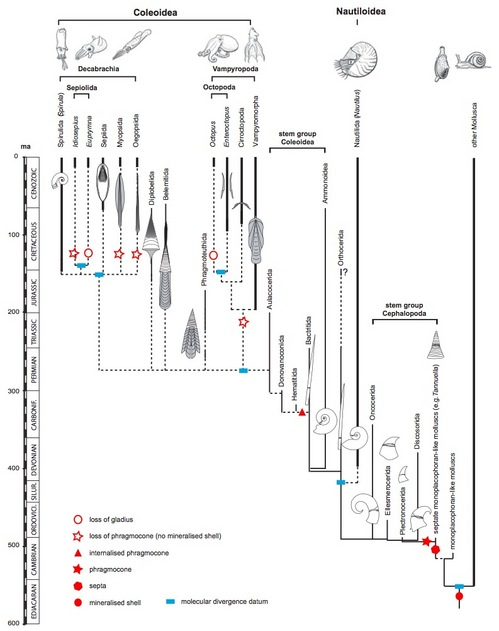Cuttlefish: The Chameleon of the Sea |
Biology 342 Fall 2011 |
Smith Freeman, Phoebe Young, and Abraham Leiser
Phylogeny
What is Phylogeny?
Phylogeny is the evolutionary history of a species, including its behaviors [6]. It often analyzes the relatedness of species to see whether a behavior was a recent development or had evolved long ago.

Cuttlefish Phylogeny
Cuttlefish, along with octopuses and squids, are a member of the group Coleoidea found in the Cephalopoda class in the phylum Mollusca [1]. Cephalopods are characterized by a set of tentacles and a specialized foot known as a siphon. There is some controversy about the placement of the genera of the Coleoidea group in relation to one another on the phylogenetic tree due to an inadequate fossil record [7].
Evolution of Chromatophores
Chromatophores are not unique to Cephalopods. They are thought to have developed through endosymbiosis of Paulinella chromatophora cells and cyanobacteria [4]. Therefore, chromatophores are found in many species including lizards, amphibians, fish, crustaceans, echinoderms, annelids, and insects [5]. In most species, chromatophores are controlled exclusively through hormones leading to slow color changes. However, in few species of lizards (especially chameleons), teleosts, and Cephalopods, control of chromatophores is neural [3], meaning that their color change is extremely rapid [5]. The neural control of chromatophores likely evolved through convergent evolution as it appears in species that do not share close relations.
All members of the class Cephalopoda except for Nautiloidea exhibit color change by chromatophores [3]. This, along with the fact that other species in the phylum Mollusca exhibit the color-changing behavior, suggests that the behavior evolved before the speciation of the cephalopod ancestor. The absence of the behavior in Nautiloidea suggests loss of the behavior in that species alone that dates back to 500 million years ago when Coleoidea and Nautiloidea shared a most recent common ancestor. The color-changing species of cephalopods use the same mechanism, but display unique patterns that evolved within the species [2].